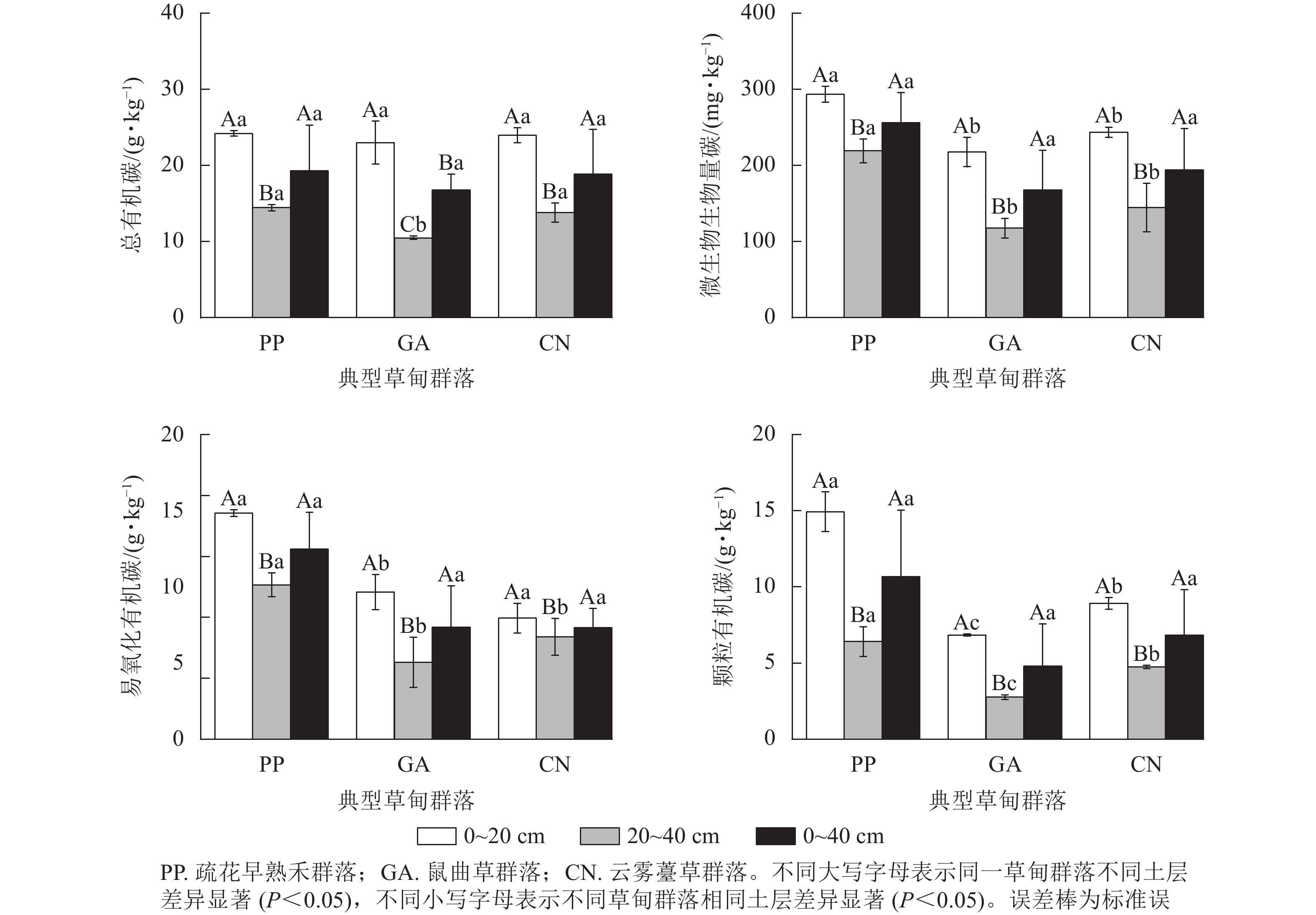-
土壤有机碳储量及碳库组分变化是全球碳循环及全球变化研究的热点问题之一。陆地生态系统中土壤碳库碳储量约为2500 Pg。土壤有机碳作为土壤碳库的重要组分,主要来源于土壤有机物在不同分解阶段产生的复杂混合物,在调节植物多样性、改变土壤理化性质和土壤肥力、减缓全球温室效应等方面发挥着极其重要的生态作用[1]。
湿地生态系统具有重要的碳汇功能,在调控全球碳平衡方面具有重要作用[2]。全球湿地面积仅占陆地的5%~8%,但湿地土壤有机碳储量却占全球土壤碳储量的20%~30%[3]。近年来,国内学者对东部沿海地区的盐城滩涂湿地[4]、西北甘肃尕海湿地[5]、中部洞庭湖湿地[3]等不同地区湿地土壤碳组分特征及影响因素进行了研究,结果表明:植被是影响湿地土壤有机碳沉积的重要因素。湿地植被类型变化能够改变凋落物分布格局[6],并导致土壤微生物、水分及其他理化性质等的一系列改变[7],进而影响到土壤碳库各组分含量的积累与分配[8]。同时,植被类型与地下水埋深之间存在复杂的相互作用和反馈机制,一方面植物会通过蒸腾作用影响地下水位,另一方面地下水位影响湿地植被生长所需要的水分和养分供给[9]。因此,揭示“植被类型—地下水埋深—土壤微生物量及理化性质—土壤有机碳储量及组分”之间的耦合关系,对于研究湿地生态功能及全球变化均具有十分重要的科学意义。
云南香格里拉纳帕海是中国典型的高原季节性湿地,孕育着丰富的生物多样性并具有显著的碳汇潜力[10]。但在自然因素与人为干扰的双重作用下,该湿地退化严重,水文条件也发生了明显改变,导致湿地植物群落与土壤环境发生改变,并影响土壤有机碳储量及各组分的积累。本研究选取不同地下水埋深的3种典型草甸群落,分析土壤有机碳储量和有机碳组分(总有机碳、微生物生物量碳、易氧化有机碳、颗粒有机碳)的变化特征,探讨湿地植物生物量、多样性及土壤性质变化对土壤有机碳储量及碳组分质量分数的影响,旨在阐明影响草甸湿地土壤有机碳储量及碳组分积累的关键影响因子。研究结果可为理解高原湿地的土壤碳循环过程提供数据支撑,同时也可为纳帕海高原湿地恢复和保护提供科学依据。
-
研究区位于云南香格里拉纳帕海湿地(27°49′~27°55′N,99°37′~99°41′E),海拔3260 m,面积3100 hm2,是在石灰岩上发育而成的喀斯特型季节性湿地[11]。该区干湿季节分明,湿地水量补给主要依靠降水,年均降水量为619 mm,其中雨季为495 mm (5—10月),旱季为124 mm (11月至翌年4月)[12]。土壤类型主要为沼泽土、沼泽化草甸土和草甸土[13]。
-
2020年11月,在纳帕海湿地依地下水埋深由高到低选取3个典型草甸群落样地,即:疏花早熟禾Poa pratensis群落(PP)、鼠曲草Gnaphalium affine群落(GA)和云雾薹草Carex nubigena群落(CN)(表1)。每个草甸群落中随机布设3个重复样地,大小50 m×10 m (间距>200 m),每个样地内再设置4个10 m×5 m的采样方,并详细记录样方内植物种类、株数和盖度等,同时采集植物标本。在固定样方内,选取50 cm×50 cm的小样方,对地上植物沿地面齐平进行刈割,去除附着土壤,立即称取植物鲜质量,随后将上述植物装入信封带回实验室,放置于105 ℃烘箱中,杀青30 min后调整温度至75 ℃,继续烘干48 h,确保植物完全烘干后称取干质量,计算植物地上生物量[14]。依据样方调查数据计算群落的Shannon-Wiener多样性指数(H)、Pielou均匀度指数(E)、Margalef丰富度指数(DMG)和Simpson优势度指数(C)[15]。
群落类型 纬度(N) 经度(E) 地下水埋深/cm 优势植物 盖度/% 土壤类型 疏花早熟禾群落(PP) 27°50′43.46″ 99°39′7.86″ −58.5±8.5 疏花早熟禾、牡蒿Artemisia japonica 90 草甸土 鼠曲草群落(GA) 27°50′43.46″ 99°38′34.60″ −112.0±6.8 鼠曲草、平车前 Plantago depressa 88 草甸土 云雾薹草群落(CN) 27°49′56.13″ 99°38′55.26″ −150.0±1.5 云雾薹草、车前P. asiatica 83 草甸土 Table 1. Basic information of the sampling sites
-
在上述样方内挖掘土壤剖面,剖面深度为45~50 cm,先去除表面植物,分别采集0~20、20~40 cm土层土样,并将同层土壤混合,剔除根系和砾石等杂物,用四分法取约1.5 kg混合土样装入无菌自封袋中,贴好标签密封,放置于冰盒内带回实验室。共采集72份土壤样品。同时用环刀分层采集原状土测定土壤容重,共采集216个环刀样。使用水位计测量地下水深度。实验室内将新鲜土样做如下处理:约100 g用于测定土壤自然含水率;约400 g放入4 ℃冰箱冷藏保存,于1周内完成土壤微生物生物量碳测定;约1 000 g自然风干15 d后,分别通过1.00和0.25 mm孔筛,用于土壤总有机碳、易氧化有机碳、颗粒有机碳、pH、全氮、全磷、全钾等指标的测定。
-
土壤理化指标测定参照《土壤农业化学分析方法》[16]。土壤容重(SBD)采用环刀法测定;土壤含水量(SWC)采用烘干称量法测定;土壤pH采用电位法(水土质量比为1.0∶2.5)测定;土壤全氮(TN)采用凯氏法消煮-全自动定氮仪测定;土壤全磷(TP)采用碱熔钼锑抗比色法测定;土壤全钾(TK)采用氢氧化钠熔融-火焰光度计法测定。每个土样测定3个平行样,取其平均值。
土壤总有机碳(TOC)采用外加热重铬酸钾氧化法[16]测定;土壤微生物生物量碳(MBC)采用硫酸钾-氯仿熏蒸法[14]测定;土壤易氧化有机碳(EOC)采用高锰酸钾氧化法[17]测定;土壤颗粒有机碳(POC)采用六偏磷酸钠分散法[18]测定。每个土样测定3个平行样,取其平均值。
-
土壤有机碳储量由土层深度、土壤容重和土壤有机碳质量分数决定,计算公式参照ELLERT等[19]。
式中:
$ M_{{\rm{SOC}}} $ 为土壤有机碳储量(t·hm−2);$d_{{\rm{BD}}i}$ 为第i层土壤容重( g·cm−3 );$M_{{\rm{SOC}}i}$ 为第i层土壤有机碳质量分数(g·kg−1);Di为第i土层厚度(cm)。 -
采用双因素方差分析法比较不同草甸群落类型及不同土层土壤总有机碳、微生物生物量碳、易氧化有机碳、颗粒有机碳质量分数的差异性;以总有机碳及其碳组分作为响应变量,以土壤理化性质(容重、含水量、pH、全氮、全磷、全钾)和地上植物(植物多样性指数、植物地上生物量)作为解释变量进行冗余分析(RDA)。通过计算Pearson相关系数(α=0.05)检验总有机碳和各有机碳组分与土壤理化指标的相关性。所有数据使用Excel 2016整理,双因素方差分析和Pearson相关系数的计算在SPSS AU中进行,绘图使用Origin 2019完成,冗余分析在Canoco 5.0中完成。
-
土壤有机碳储量(0~40 cm土层)在不同典型草甸群落中差异显著(图1,P<0.05),从大到小依次为疏花早熟禾群落(47.55 t·hm−2)、云雾薹草群落(42.28 t·hm−2)、鼠曲草群落(32.14 t·hm−2),其中疏花早熟禾群落是鼠曲草群落的1.5倍;土壤碳储量垂直分布均为随着土层加深而显著下降(P<0.05),其中0~20 cm土层碳储量均值占总量的57.10%~63.85%,鼠曲草群落垂直变化幅度最大,从上层到下层减小1.8倍。
-
图2表明:随着地下水埋深降低, 0~40 cm土层土壤总有机碳、微生物生物量碳、易氧化有机碳和颗粒有机碳均值呈减少趋势,但差异不显著(P>0.05),最大值均出现在疏花早熟禾群落(19.33 g·kg−1、256.32 mg·kg−1、15.61 g·kg−1、10.67 g·kg−1)。垂直变化幅度上,土壤碳组分在鼠曲草群落中变化幅度最大,从上层到下层分别减小2.0、1.8、1.9、2.5倍,在云雾薹草群落变幅最小,分别为1.3、1.2、1.9倍。
-
由表2可知:不同典型草甸群落多样性差异显著(P<0.05)。随着地下水位加深,植物Shannon-Wiener多样性指数、Pielou均匀度指数、Margalef丰富度指数和Simpson优势度指数均显著增加,在疏花早熟禾群落中最大,分别是云雾薹草群落的2.3、1.6、2.5和1.5倍。
样地名称 地上生物量/(g·m−2) Shannon-Wiener多样性指数 Pielou均匀度指数 Margalef丰富度指数 Simpson优势度指数 疏花早熟禾群落 646.94±69.16 a 3.71±0.02 a 0.93±0.01a 13.11±0.38 a 0.92±0.02 a 鼠曲草群落 337.45±43.66 b 2.87±0.01 b 0.87±0.06 b 9.49±0.68 b 0.86±0.01 b 云雾薹草群落 229.58±1.87 c 1.58±0.30 c 0.57±0.09 c 5.19±0.39 c 0.62±0.07 c 说明:同列不同小写字母表示不同典型草甸群落多样性差异显著(P<0.05)。数值为平均值±标准误 Table 2. Characteristics of above-ground biomass and diversity in typical meadow community of Napahai
-
从表3可看出:不同典型草甸群落土壤理化性质差异显著(P<0.05)。土壤含水量、pH、全磷的最大值出现在疏花早熟禾群落(25.48%、8.35、0.51 g·kg−1),最小值在鼠曲草群落(21.41%、5.14、0.42 g·kg−1);土壤容重、全钾则与之相反,最大值出现在鼠曲草群落(1.28 g·cm−3、34.03 g·kg−1);土壤全氮在云雾薹草群落中最大(1.70 g·kg−1),在疏花早熟禾群落中最小(1.20 g·kg−1);土壤全磷在疏花早熟禾群落最大(0.51 g·kg−1)。垂直变化方面,各群落土壤理化性质随着土层加深呈现不同的变化规律。土壤容重和pH随着土层加深而增大。土壤含水量、全氧、全磷、全钾随着土层加深呈显著减小(P<0.05)。变化幅度上,土壤含水量变化幅度最大出现在云雾薹草群落,幅度为1.2倍,疏花早熟禾群落的土壤变化幅度最大,幅度为1.4倍,土壤全氮、全磷、全钾变幅度最大值分别为云雾薹草群落(2.0倍)、鼠曲草群落(1.2倍)和疏花早熟禾群落(1.0倍)。
植物群落 地下水位/cm 土层深度/cm 土壤含水量/% 容重/(g·cm−3) pH 全氮/(g·kg−1) 全磷/(g·kg−1) 全钾/(g·kg−1) 疏花早熟禾群落 −58.5 0~20 26.66±0.85 Aa 1.01±0.01 Cb 8.54±0.08 Aa 1.38±0.03 Ab 0.54±0.03 Aa 33.59±2.34 Ba 20~40 24.29±0.70 Ba 1.22±0.03 Ab 8.54±0.06 Aa 0.85±0.08 Ba 0.48±0.03 Ba 35.90±0.45 Aa 0~40 25.48±0.61 Aa 1.11±0.02 Bb 8.35±0.37 Aa 1.20±0.16 Ab 0.51±0.03 Aa 30.57±2.45 Ca 鼠曲草群落 −112.0 0~20 22.17±0.40 Ab 1.23±0.12 Aa 4.97±0.11 Ac 1.44±0.16 Ab 0.47±0.04 Ab 28.03±0.57 Ab 20~40 20.65±0.37 Cc 1.32±0.04 Aa 5.44±0.41 Ac 0.91±0.02 Ba 0.38±0.03 Bb 28.36±0.24 Ab 0~40 21.41±0.28 Bc 1.28±0.10 Aa 5.14±0.27 Ac 1.31±0.17 Ab 0.42±0.03 Ab 28.45±1.39 Aa 云雾薹草群落 −150.0 0~20 25.61±0.52 Aa 0.96±0.03 Cc 6.87±0.25 Ab 1.84±0.11 Aa 0.46±0.02 Ab 34.03±0.91 Aa 20~40 21.58±0.72 Bb 1.28±0.04 Aa 7.28±0.45 Ab 0.93±0.42 Ba 0.39±0.01 Cb 28.78±0.20 Cb 0~40 23.59±3.70 Aa 1.12±0.01 Bb 7.07±0.52 Ab 1.70±0.19 Aa 0.42±0.01 Bb 32.60±3.74 Ba 说明:不同大写字母表示同一典型草甸群落不同土层差异显著(P<0.05),不同小写字母表示不同典型草甸群落相同土层差异显著(P<0.05)。数值为平均值±标准误 Table 3. Characteristics of soil physicochemical properties of typical meadow communities of Napahai
-
从表4可知:植物多样性、地上生物量及土壤理化性质对土壤有机碳储量及碳组分的影响因子存在一定差异。其中植物多样性和地上生物量均与有机碳储量及碳组分呈极显著(P<0.01)或显著(P<0.05)正相关;土壤含水量与总有机碳呈显著正相关(P<0.05),与颗粒有机碳呈极显著正相关(P<0.01);土壤容重与总有机碳和颗粒有机碳呈极显著负相关(P<0.01),与微生物生物量碳呈显著负相关(P<0.05);全氮与有机碳储量、微生物生物量碳呈显著正相关(P<0.05),与总有机碳和颗粒有机碳呈极显著正相关(P<0.01);全磷与微生物生物量碳呈显著正相关(P<0.05),与颗粒有机碳呈极显著正相关(P<0.01);全钾仅与颗粒有机碳呈显著正相关(P<0.05)。
指标 Shannon-Wiener
指数Pielou
指数Margalef
指数Simpson
指数地上生
物量土壤含
水量容重 pH 全氮 全磷 全钾 总有机碳 0.718** 0.784** 0.664** 0.791** 0.612** 0.343* −0.596** −0.100 0.585** 0.259 0.265 微生物生物量碳 0.645** 0.654** 0.616** 0.649** 0.564** 0.290 −0.372* 0.144 0.339* 0.335* 0.057 易氧化有机碳 0.204 0.169 0.272 0.176 0.448** 0.129 −0.068 0.097 −0.116 0.086 0.137 颗粒有机碳 0.773** 0.767** 0.775** 0.765** 0.859** 0.620** −0.758** 0.172 0.482** 0.439** 0.370* 有机碳储量 0.457** 0.549** 0.402* 0.558** 0.409* 0.097 −0.256 −0.250 0.381* 0.065 0.112 说明:*P<0.05; **P<0.01 Table 4. Correlation coefficients between the soil organic carbon components and environment factors of soil
以植物地上生物量、多样性指数及土壤环境因子为解释变量,土壤有机碳储量和碳组分为响应变量进行RDA分析,结果表明(图3):有机碳储量与总有机碳、微生物生物量碳夹角最小,而与Pielou均匀度指数(E)、Simpson优势度指数(C)、Margalef丰富度指数(DMG)、Shannon-Wiener多样性指数(H)、地上部生物量、全氮夹角次之,说明总有机碳与微生物生物量是土壤有机碳储量形成的主要控制者,Pielou均匀度指数、Simpson优势度指数、Margalef丰富度指数、Shannon-Wiener多样性指数、地上部生物量、全氮是土壤有机碳储量的主要影响因子。土壤碳组分与Shannon-Wiener多样性指数、Pielou均匀度指数、Margalef丰富度指数和Simpson优势度指数、全磷、土壤含水量及地上生物量的夹角最小,说明地上生物量、植物多样性、全磷、土壤含水量是促进土壤有机碳储量和碳组分的主控因子。
-
植物残体腐质化进入土壤是有机碳的主要来源,不同植被类型具有不同的物种组成与丰富度,导致地上生物量、土壤动物和微生物活性的差异,直接影响到土壤有机碳的积累与分解,由此形成不同植被类型土壤有机碳的分布格局[20]。本研究发现:疏花早熟禾群落土壤有机碳储量最大。这与李宁云等[21]的研究结果相一致,主要原因是疏花早熟禾群落植被盖度、多样性和地上生物量最大,其植物光合作用和固碳能力最强。另外,该群落地下水埋深最高,湿地土壤有机碳与水分存在相互作用[9],土壤水分增加从而减缓氧化分解速率,进一步促进土壤有机质积累,最终促进土壤碳积累,增强其碳汇能力[22]。土壤有机碳储量最小值出现在鼠曲草群落,可能与该群落位于湖泊附近,存在季节性水位变化相关。MOCHE等[23]研究认为:反复的淹水和退水会使土壤固碳能力下降。本研究中土壤碳储量的范围为64.28~95.11 t·hm−2,超过中国大部分低海拔地区的湿地[24−25],因此高原湿地碳库的重要性不言而喻。减缓纳帕海高原湿地植被退化并恢复已退化植被的工作刻不容缓。
土壤有机碳储量主要来源于地表植物和土壤养分等,并受地上生物的矿化分解、转化、累积影响[25]。本研究发现:植物多样性指数、地上生物量和土壤全氮与土壤有机碳储量均呈正相关关系,这与梁春玲[3]研究结果相似,说明植被多样性、地上生物量和土壤全氮随地下水埋深的变化,直接调控了土壤碳在不同地下水埋深处的积累。冗余分析显示:总有机碳是土壤有机碳储量的主要贡献者,且土壤容重与碳储量呈负相关,这也与已有研究一致[23]。土壤容重越大,土壤有机碳和土壤微生物生物量碳质量分数减小,进而影响土壤有机碳储量[26]。
本研究中,3种典型草甸群落类型土壤碳储量均随着土层加深而减小,这与前人研究结果一致[21, 27]。植物生长时通过“根际沉降”使有机碳积累[26],草甸植物根系集中分布在0~20 cm土层[28],有机碳难以通过根系输入到深层土壤,因此土壤碳储量随土层加深而减小,这也表明表层土壤具有重要的碳汇功能。在3种典型草甸群落中,鼠曲草群落土壤碳储量从上层到下层的下降幅度最大,这可能是因为该群落表层具有较高的植物多样性指数和地上生物量,“根际沉降”使得有机碳富集在表层土壤,但随着土层加深,土壤含水量减少,抑制了土壤微生物的繁殖,加上采样季节正处冬季,较低的土温又降低了微生物的活性[29]。
-
不同典型草甸群落地表植被覆盖及土壤环境的改变,能够引起土壤碳组分的显著变化,但由于不同土壤碳组分具有不同来源与性质,其对植被类型变化的响应具有一定的变异性[30]。土壤微生物生物量碳和易氧化有机碳是土壤活性有机碳库中最重要的组分。其中,土壤易氧化有机碳周转速率最快且最先被氧化[31],而微生物生物量碳则反映了土壤中微生物和动植物残体等的数量,能够表征土壤碳、氮、磷等养分循环状况,在调控湿地物质循环过程中具有重要作用[32]。土壤颗粒有机碳相对稳定,其多少决定了该地区碳库的稳定性[33]。
本研究中,土壤总有机碳、微生物生物量碳、易氧化有机碳、颗粒有机碳最大值均出现在疏花早熟禾群落。这可能与群落盖度、植物多样性指数、地上生物量和地下水位有关。高水位导致土壤通气状况差,抑制了微生物活性及土壤呼吸,从而抑制了有机质的分解,促进了总有机碳的积累[34]。此外,在本研究中土壤总有机碳质量分数显著高于东部滨海滩涂湿地[4]、洞庭湖湿地[3]等低海拔湿地,表明纳帕海高原湿地土壤具有较大的固碳潜力。疏花早熟禾群落具有最高的地上生物量,为微生物提供了充分的碳源,从而具有较高的微生物生物量碳。疏花早熟禾群落较高的地上生物量,输入土壤的凋落物量高于鼠曲草和云雾薹草群落,促进了土壤易氧化有机碳的积累。另外,可能由于疏花早熟禾有利于湿地土壤团聚性的形成与稳定,从而使得其颗粒有机碳质量分数大于其他2个样地[35]。
3种典型草甸群落土壤总有机碳、微生物生物量碳、易氧化有机碳、颗粒有机碳质量分数均随着土层的加深而显著减小(P<0.05)。随着地下水埋深加深,容重增大,土壤有机碳分解速率随通气性减弱而减小,深层土壤碳组分质量分数减少。在本研究中,地下水埋深的高低以及深层土壤环境的差异,导致了在不同土壤层次间碳组分的相对含量及其变化趋势因群落类型而有不同变化趋势。其中,有机碳组分在鼠曲草群落中的减小幅度最大。这可能与该群落的地下水埋深高度有关,同时,纳帕海高原湿地干湿季分明,位于湖泊附近的鼠曲草群落在反复的季节性淹水和退水的水文条件下,地下水埋深波动较大,导致土壤胶体形态、土壤结构、容重和粒径等性质的改变,使原来不能分解的有机质因团聚体的分散而分解[36]。土壤总有机碳、微生物生物量碳在疏花早熟禾群落的垂直变化幅度最小,土壤易氧化有机碳、颗粒有机碳在云雾薹草群落的降幅最小。这可能是由于疏花早熟禾群落具有最高的地上生物量,为微生物提供了充分的碳源,促进了微生物特别是厌氧微生物数量的增长。云雾薹草群落地下水埋深最低,受地下水波动影响较小,表层和深层土壤结构较为稳定,故降幅最小。
-
植物是草甸土壤有机碳输入的主要来源,地下水位埋深的变化能够引起湿地植物多样性、地上生物量和土壤理化性质的改变,进而显著影响湿地土壤碳组分的积累[37]。土壤总有机碳、微生物生物量碳、易氧化有机碳、颗粒有机碳均与植物多样性指数呈正相关关系,说明随着地下水埋深降低,地表植物多样性呈减少趋势,进而导致此4种碳组分质量分数随地下水埋深降低而呈现显著减少格局。朱丽等[37]在海流兔河研究发现:随着地下水位的降低,植物物种数显著减少,同时,水位埋深变化影响最大根系深度、根系形态特征和生理特性。这些特征又对根系向土壤的碳输入产生影响[38]。水位埋深降低导致根系栓质化,造成根系分泌物数量降低以及细根的周转期延长,最终减缓根系对土壤的碳输入[7]。
土壤pH作为湿地生态功能的重要调控因子,能够直接影响土壤微生物的活性,从而对有机碳组分产生显著影响[3]。但在本研究中,pH对土壤有机碳组分质量分数的解释率最低,这可能和地下水埋深有关,水位的高低决定了土壤酸性离子流失量。地下水埋深越高,土壤pH值越大[39]。本研究中,3种典型草甸植物群落所在样地的地下水位埋深差异显著(P<0.05),这也是各群落土壤pH差异显著的原因之一。全氮是影响土壤有机碳组分的主控因子之一,相关分析也表明:土壤有机碳组分(总有机碳、微生物生物量碳、颗粒有机碳)沿地下水埋深变化对全氮存在显著正效应(P<0.05)。这与尹鹏松等[40]研究结果相似。这可能由于土壤全氮增加可显著刺激土壤微生物多样性,从而促进土壤有机碳的固持[41]。孟妍君等[35]研究亦表明:土壤氮等底物利用率增加通过刺激土壤微生物多样性促进土壤有机碳的积累,并且土壤全氮可以直接影响土壤微生物的种类、数量及活性,从而影响土壤碳转化过程[37]。土壤全磷对土壤易氧化有机碳和颗粒有机碳存在正向效应,这与徐耀文等[42]研究结果相似。本研究中土壤全磷质量分数最大值出现在水位高埋深处。作为限制湿地植物生长的主要元素,土壤磷增加可通过刺激植物与微生物的生长影响土壤碳的输入,进而促进土壤碳组分积累[7]。
-
湿地植物群落、土壤理化性质与地下水埋深在空间尺度上存在一定的交互作用,进而导致了土壤有机碳质量分数及碳组分的空间变化。随地下水埋深的降低,3个草甸植物群落地上生物量和物种多样性指数下降1.5~2.3倍,土壤有机碳储量及碳组分质量分数降低了1.0~2.2倍,沿土层下降1.2~2.5倍。冗余分析显示:总有机碳和微生物生物量碳质量分数变化是土壤有机碳储量的主要贡献者,而植物多样性、全氮是总有机碳、微生物生物量碳的主要影响因子,植物地上生物量、土壤全磷及土壤含水量是影响颗粒有机碳和易氧化有机碳变化的主控因子。因此,探明草甸植物生物量和多样性以及水文和土壤养分供应状况的改变及其对土壤有机碳沉积的影响,是未来全球变化加剧背景下湿地土壤碳积累与分配时空格局及调控机制研究的核心内容。
本研究采样时间处于研究区的干季,今后还可对纳帕海典型草甸湿地土壤碳储量及碳组分的干湿季变化和年变化开展研究。
Changes of soil organic carbon storage and carbon components in typical meadow communities in Napahai
doi: 10.11833/j.issn.2095-0756.20220377
- Received Date: 2022-06-01
- Accepted Date: 2022-10-09
- Rev Recd Date: 2022-10-06
- Available Online: 2022-11-11
- Publish Date: 2023-04-20
-
Key words:
- Napahai wetland /
- typical meadow communities /
- soil carbon storage /
- soil carbon components /
- groundwater depth
Abstract:
| Citation: | LIU Pan, LU Mei, LI Cong, et al. Changes of soil organic carbon storage and carbon components in typical meadow communities in Napahai[J]. Journal of Zhejiang A&F University, 2023, 40(2): 274-284. DOI: 10.11833/j.issn.2095-0756.20220377 |




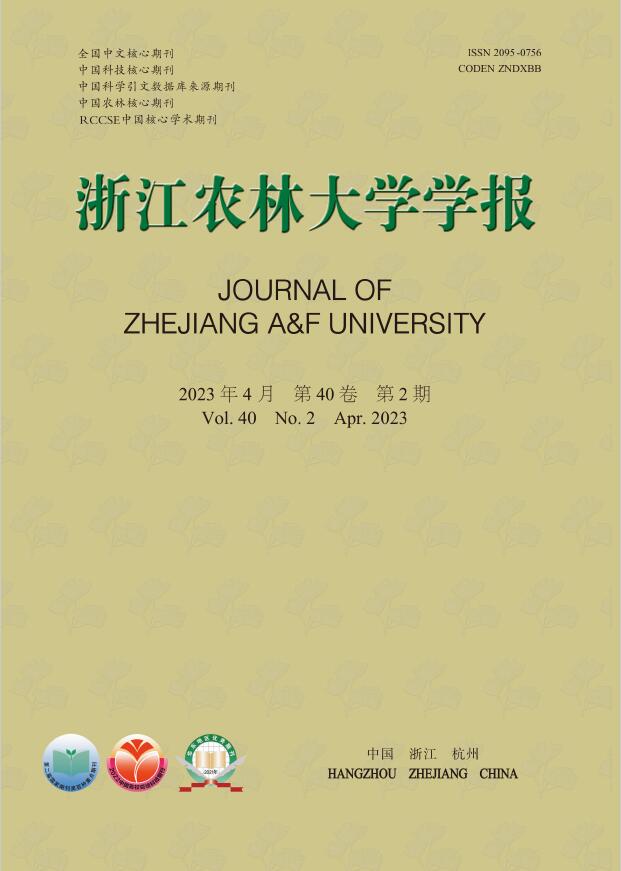


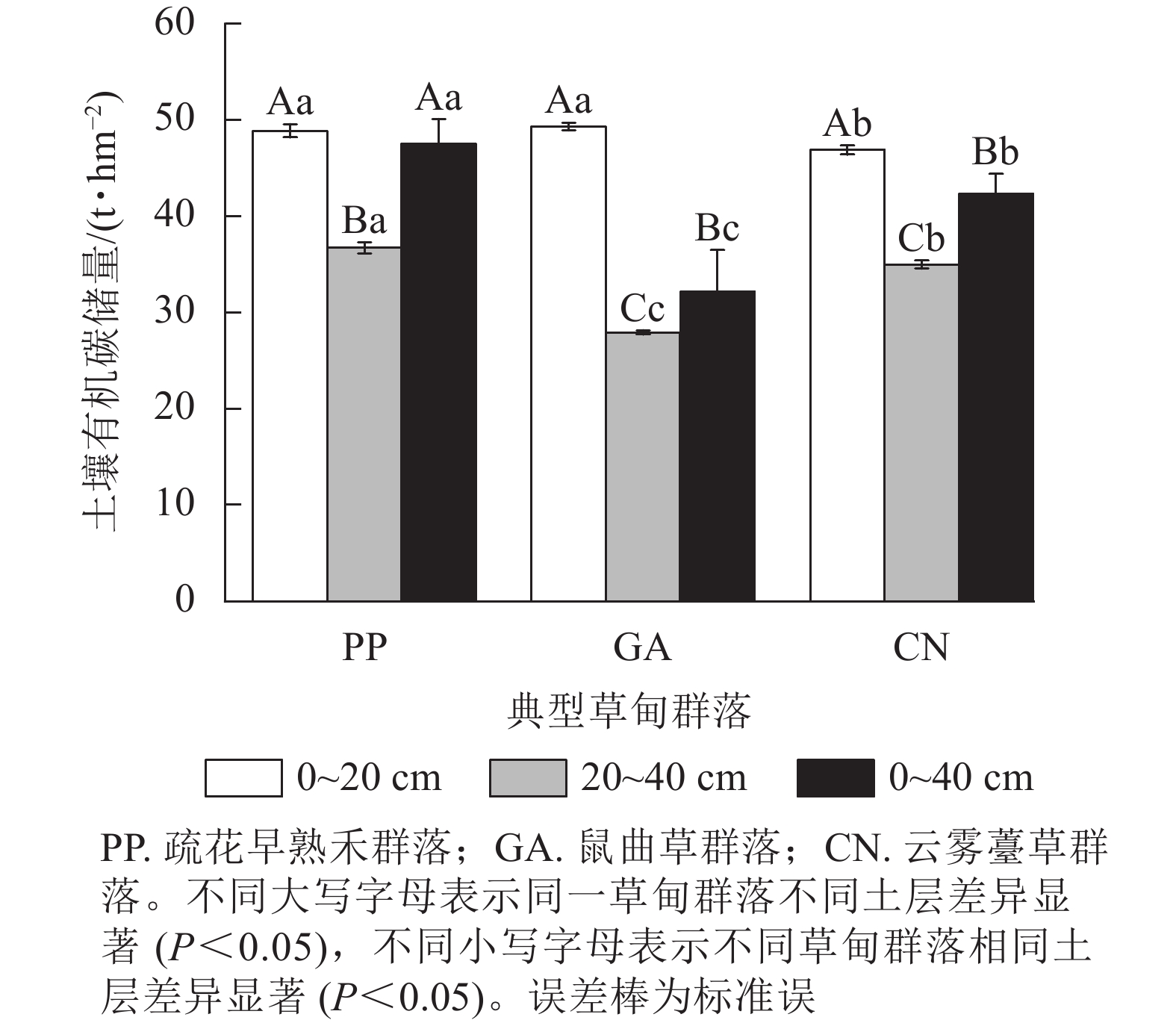





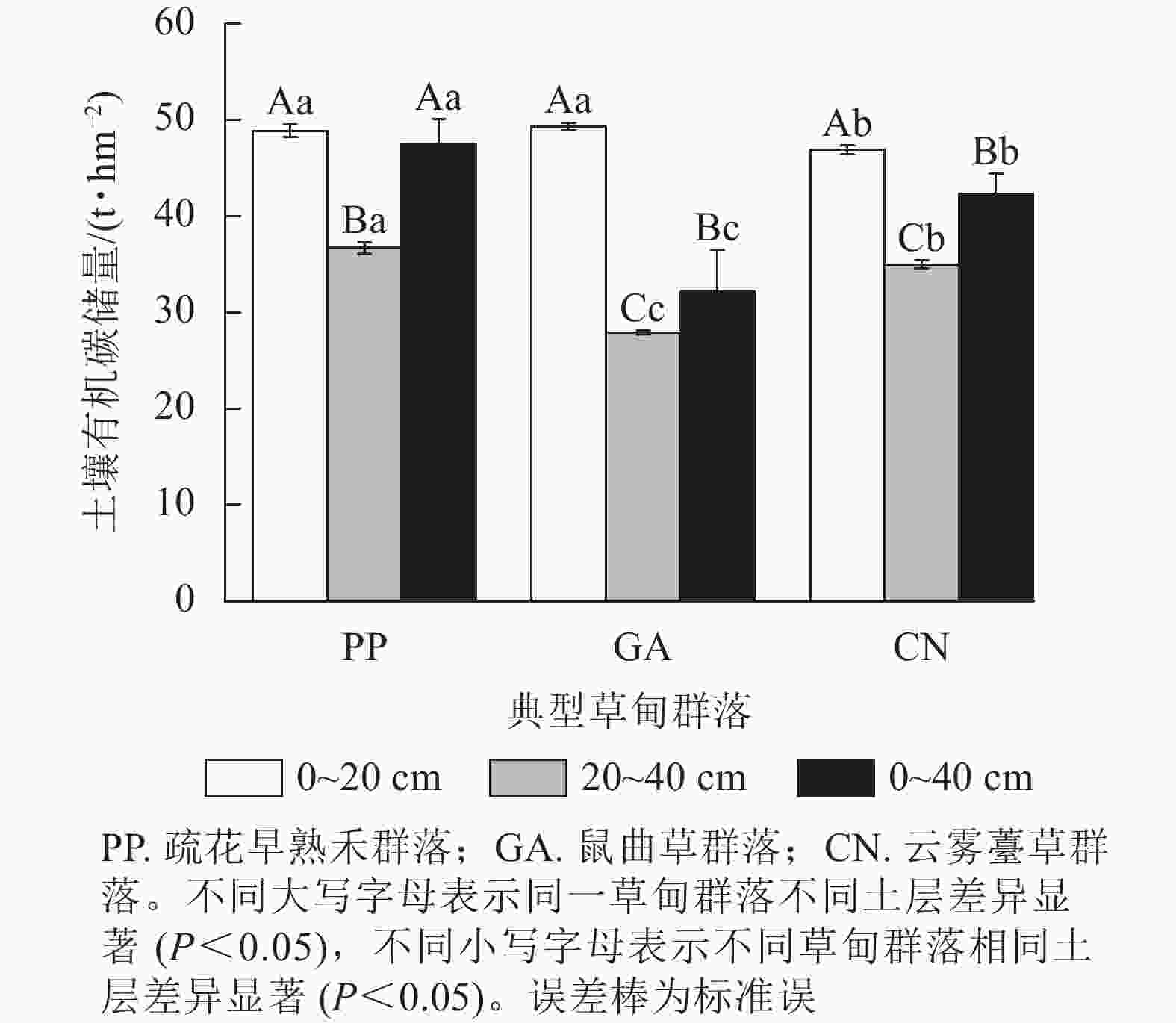
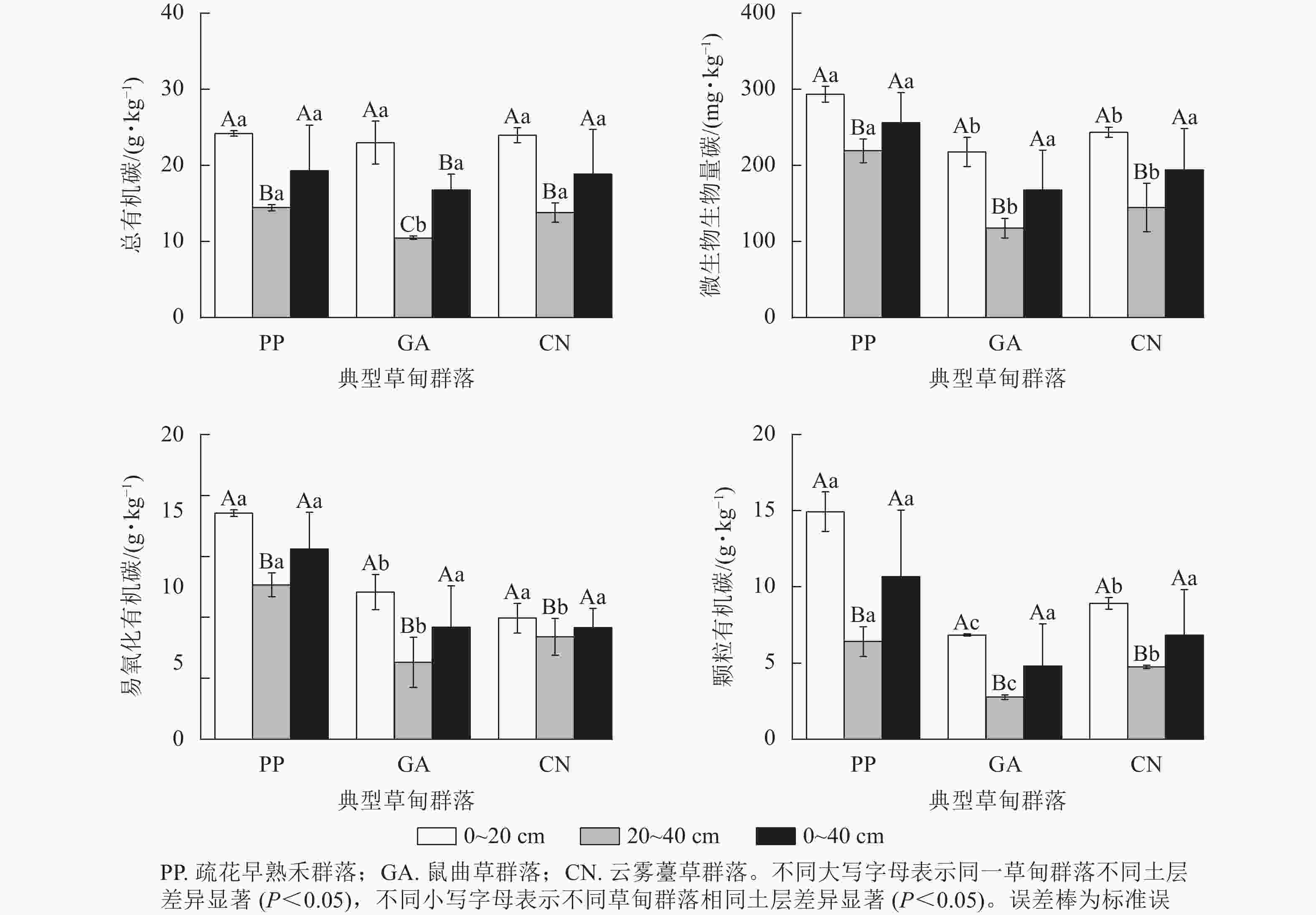
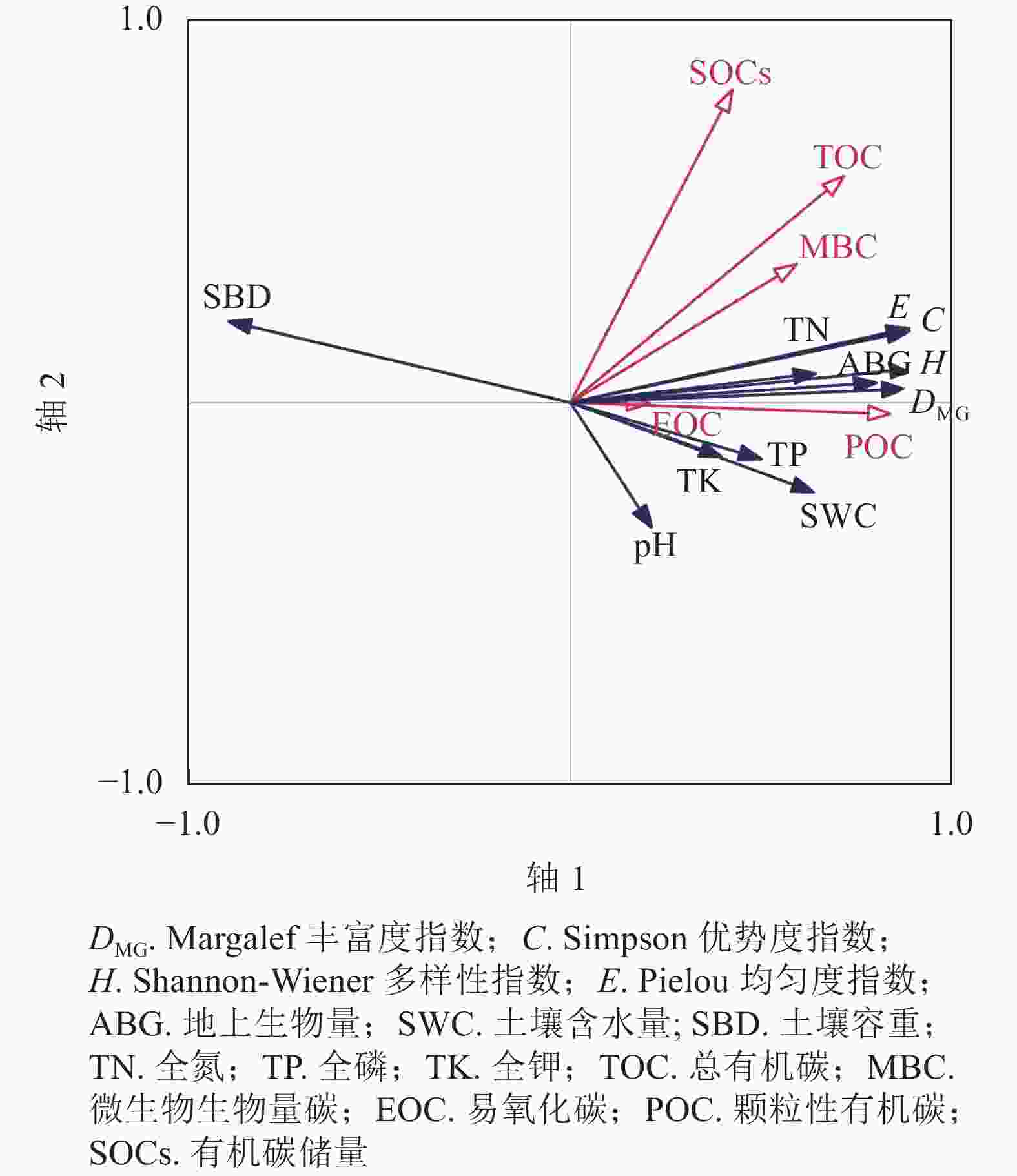
 DownLoad:
DownLoad:
